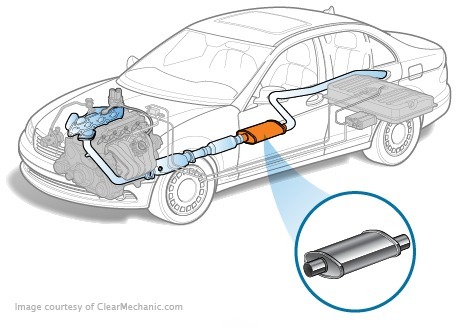
Silencer-vehicle exhaust system element that reduces engine noise to an acceptable level. This is perhaps the most prominent part of the exhaust system of a car, perhaps because it, unlike the resonator, can be seen under the bottom without getting under the car. History of the introduction of a silencer
History of the introduction of a silencer
At the dawn of the car, exhaust systems were not equipped with silencers. The way the car was going somewhere nearby could be heard on loud roar and clouds of black smoke. Despite the fact that the vehicles were very small, the few copies were scathing not only of the inhabitants of the cities, but also of the horses, who remained the main means of transport.
The silencer is often confused with the resonator-absorption device, which is always closer to the engine in the system
The situation was not satisfactory for the population, and the road developers had to take care that noisy vehicles would not inconvenience the environment. The first silencer was installed on the motor vehicle in 1894. It was used in a French car company "Panhard-Levassor". Development has become popular, and the development of exhaust systems has become a seven-step step.
Silencing device
The silencer is a sealed metal chamber with a capacity of several litres. As a rule, it resemves a large flask of cylindrical or dormant form (which, by the way, has led to the emergence of a jargon name of the "bank"), and closed from the top and bottom with flat walls. The more the volume of the keg, the better the characteristics of the silencer. The front wall of the tube is welded to the midpoint of the exhaust path and to the rear wall by welding the exhaust pipe which exhaust the exhaust gas flow out. Inside the "banks" there are numerous bulkheads with holes that make up the chambers of the chamber. Passing silencer, the pulsating flow of exhaust gases gradually flattens and the sound waves disperse. In addition to partitions, there is a perforated pipe, a steel net and a acoustic upholstery. The body is usually made of stainless steel, and in cheaper performance from steel coated with a thin layer of aluminium (to avoid corrosion). The steel grid performs the reinforcement function without allowing the "bank" to be swolled under the influence of internal pressure. The absorbing material shall be made of non-combustible fiberglass.
Among the fans of direct silencers is the competition, the purpose of which is to find the most "noble" sound of the tuning exhaust system
There are two main types of silencers: direct and obtuse. The recorder provides sound waves through the perforated tube, and then through the mesh and upholstery. Similarly, the resonator is designed to serve as the primary absorbing roar of the engine in the established exhaust systems. The reverse flow gas flow changes its direction by 90 to 360 degrees, and then unfold again before exiting.
Symptoms of the silencer
As with any element of the exhaust system, the silencer shall be subjected to the corrosive gases from the inside and to the corrosion of the silencer from the outside, so it may be inoperable. The most visible sign of a malfunction is the increase in noise, the knee under the bottom of the car and the sudden smell of the exhaust in the passenger compartment and around the car.
Causes of Defects
The failure could be caused by the formation of holes in the hull due to the ingenation of stones or mechanical deformation and the appearance of rust. In the first case, it is possible to repair with welding, but it is only a temporary measure. It is likely that a complete replacement will eventually be required.
For the repair of the silencer, there are many "people" means-from aluminum wire to glass fibre and epoxy adhesive. All these are only temporary measures to delay the purchase of new details
In the case of corrosion, the welding is also practiced-the rusted metal is cut and the opening of the metal is covered by the steel sheet. However, in either case, a more efficient measure will be a complete replacement of the broken spare parts.
Options for the location of the silencer
As a general rule, the silencer shall be located near the bottom of the passenger car body. However, for various reasons, as a rule of aesthetic character, it may be moved to another location. For example, Dodge Viper, a sports car of American manufacturing, is located in the middle of the body, and the tailpipe is outside the door and is looking at the side. In the case of an extremely short exhaust system, modified for the purpose of optimizing the performance of the vehicle, the silencer may be located in the subspace and the exhaust pipe may come out through the wheel arch. However, this system is rarely used in serial cars because of a higher level of fire risk.









